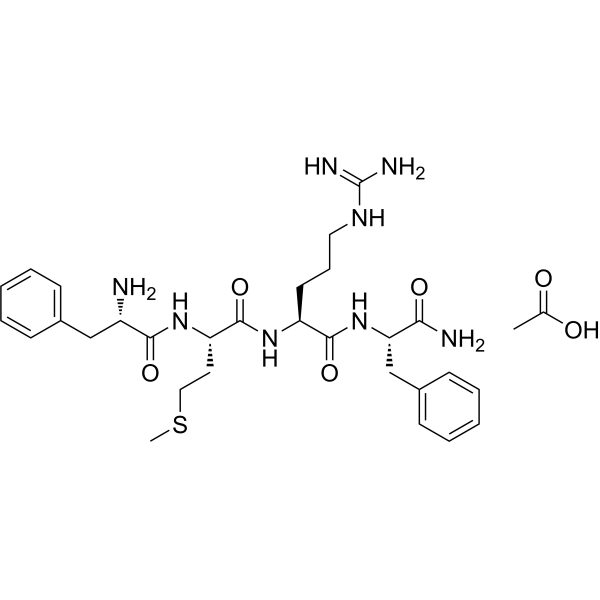H-Phe-Met-Arg-Phe-NH2 acetate salt
Modify Date: 2024-01-02 15:40:08

H-Phe-Met-Arg-Phe-NH2 acetate salt structure
|
Common Name | H-Phe-Met-Arg-Phe-NH2 acetate salt | ||
|---|---|---|---|---|
| CAS Number | 152165-14-5 | Molecular Weight | 658.81 | |
| Density | N/A | Boiling Point | N/A | |
| Molecular Formula | C31H46N8O6S | Melting Point | N/A | |
| MSDS | Chinese | Flash Point | N/A | |
Use of H-Phe-Met-Arg-Phe-NH2 acetate saltPhe-Met-Arg-Phe, amide acetate dose dependently (ED50=23 nM) activates a K+ current in the peptidergic caudodorsal neurons[1]. |
| Name | fmrf amide |
|---|---|
| Synonym | More Synonyms |
| Description | Phe-Met-Arg-Phe, amide acetate dose dependently (ED50=23 nM) activates a K+ current in the peptidergic caudodorsal neurons[1]. |
|---|---|
| Related Catalog | |
| Target |
ED50: 23 nM (K+ current)[1] |
| In Vitro | In the molluscan central nervous system, Phe-Met-Arg-Phe, amide (FMRFa) acetate acts on K+ channels in sensory, motor-, and neuroendocrine neurones. Phe-Met-Arg-Phe, amide acetate activates a novel K+ current that is characterized by a combined voltage- and receptor-dependent gating mechanism, with both factors being necessary for opening of the channels[1]. Phe-Met-Arg-Phe, amide (1 μM) acetate significantly inhibits glucose stimulated (300 mg/dL) insulin release (p<0.005) and somatostatin release (p<0.01) from the isolated perfused pancreas[2]. Phe-Met-Arg-Phe, amide (FMRF-NH2) (1 and 10 μM) acetate is without effect on glucagon secretion, either in low glucose (50 mg/dL), high glucose (300 mg/dL), or during arginine stimulation (5 mM)[2]. |
| In Vivo | Phe-Met-Arg-Phe, amide (FMRFamide) acetate stimulates growth hormone secretion in conscious OVX rats. The presence of Phe-Met-Arg-Phe, amide-like immunoreactivity in neuronal elements in the hypothalamus suggested a role for this in the hypothalamic control of the anterior pituitary function. The injection of 200 ng (313.8 pM) of FMRFamide (in 2 uL) produces a significantly increased plasma GH 15 min after injection. The GH-increasing effect of 400-800 ng (627-1255 pM) of FMRFamide is already developed after 5 min and lasted up to 30 min[3]. |
| References |
| Molecular Formula | C31H46N8O6S |
|---|---|
| Molecular Weight | 658.81 |
| Exact Mass | 598.30500 |
| PSA | 243.61000 |
| LogP | 3.51940 |
| h-phe-met-arg-phe-nh2 acoh |
| fmrf-nh2 |
| phe-met-arg-phe-nh2 |
| molluscan cardioexcitatory peptide |
| fmrfamide acetate salt |
| phe-met-arg-phe-nh2 1/2acoh 2h2o |
| h-phe-met-arg-phe-nh2 |
| phe-met-arg-phe amide |
| fmrf-amide 1 1/2acoh 2h2o |

